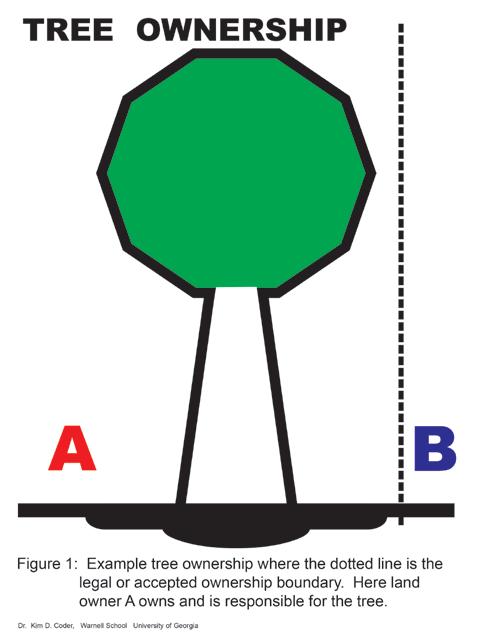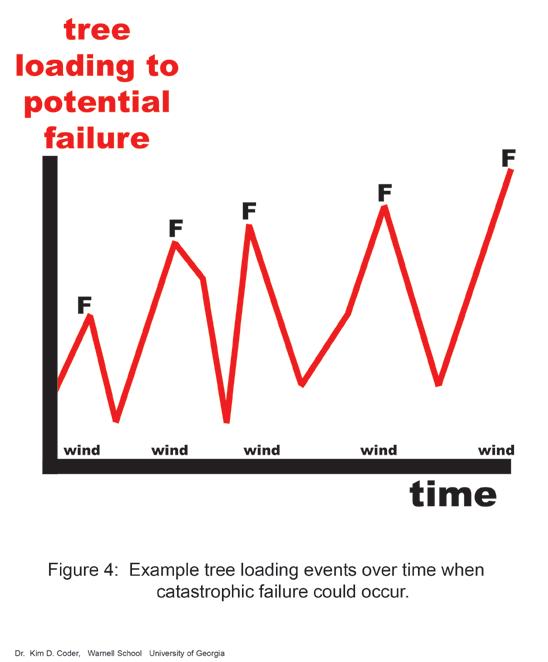
9 minute read
Managing community forests, part 1 Risk hazard and assessment
Managing community forests, part 1
Tree risk and hazard assessment concepts
by Dr. Kim D. Coder, Professor of Tree Biology & Health Care, Warnell School, UGA
Andrew Koeser, International Society of Arboriculture, Bugwood.org
Management of community forests includes
tree maintenance, protection and problem prevention. Management denotes resource expertise at the organism level, and familiarity and working knowledge of social systems. In addition, costeffectiveness over the long-run binds objectives, anticipation of change, recognition of tree stress and strain, mitigating treatments, and evaluation of results into a core of resource management decision making which demands up-to-date and conscientious managers.
A manager must know the tools and expected results of urban forest maintenance. A manager must also understand how to technically assess the condition of the resource. Risk awareness and hazard assessments are critical components of urban forest inventories. These assessments should be systematically completed by trained professionals. There are several means and methods for assessing current risk and hazardous conditions, and anticipating potential risks over time within the community forest.
Appreciating risk
Community foresters are risk managers. Most large corporations and public institutions have people assigned to risk management with the stated goal of reducing liability exposure. The community forest has many risks associated with its functions and values it produces. At the very least, trees are tall, large, and dense structures which can lose parts or catastrophically fail. Assessment of tree-associated risk requires specific training and familiarity with both how the legal system treats tree issues, and how trees and their sites develop across time.
One of the most glaring word uses in risk assessment is the word “hazard.” The word hazard, for both lay-people and professionals denote some threshold of risk has been surpassed.
Hazard also conveys the immediacy of structural failure as determined by a tree professional.
Within community forestry, it is critical the word “hazard” be used only in association with situations where an actual hazard has been identified.
The hazard concept demands a completed evaluation and assessment of risk which reaches a management threshold where the situation cannot be allowed to continue. Beware of the misuse or overuse of the word “hazard.”
Risk Is everywhere
Every landscape and tree situation has risk involved. Nothing is risk free. All trees carry some amount of risk. A level of risk under some management regimes could be hazardous, while under other management objectives could be acceptable. Some situations allow more risk to be accepted and managed, while other situations would call for immediate tree removal and risk reduction.
Because all trees have risk associated with them, discussion of the structural integrity of a tree
should include assessing the level of risk present. It is the amount of risk present, perceptions of the risk manager, and willingness to accept or not accept a given level of risk which determines hazard. Any tree is not necessarily hazardous, but all carry some level of assessable risk which professionals can estimate.
Tree values and liabilities
One fundamental concept in community forest management is trees have value, provide benefits, and are desired by humans. People find great psychological, monetary, aesthetic, and utilitarian values in trees. Some of the benefits of trees which people enjoy include recreation, psychological calming, shade, heat dissipation, blockage of glare, blockage of noise, production of white noise, reduction of pollutants, production of oxygen, reduction of erosion, wildlife habitat, increased property values, and increased economic stability. Many more values and functions could be added.
Trees have great benefits but also have costs. Tree associated costs include capital infrastructure investments, foregone alternative investments, installation, maintenance, management, and removal. One cost is managing liability risk. Liabilities include ecological, biological, aesthetic, social, economic, and safety risks. You cannot eliminate liability risk from trees unless the entire above and below ground structure is removed from a site. With trees removed, a site still does not remain risk free. A manager can reduce liability risks and keep trees and sites below a risk management acceptance threshold, in most cases. People want trees, but they also need to be safe from threats to property and physical injury.
Decisions
Part of management is being aware of potential risks associated with trees, identifying risks, and then minimizing risks within constraints of site management objectives. This risk assessment process depends upon professional judgements and decisions (or lack of decisions). Every professional decision must be made for one or all of the following reasons: asset protection, asset appreciation, minimization of liability risks (future), public safety (present), and/or to fulfil site management objectives.
Understanding the structure of trees, symptoms of impending structural failure, treatments available to minimize the chance of structural failure, and how trees finally fail are essential knowledge to a community forest manager. Understanding the risks of structural failure is as important as any other component of a manager’s job.



Tree types
There are three classes of trees in the landscape related to levels of risk.
The first is a “hazard tree.” Attributes of a hazard tree are: 1) major structural faults potentially leading to catastrophic loss; 2) identifiable target (people or property); and, 3) an unacceptable management risk.
The second class of tree is a “tree at risk” of catastrophic failure or with a significant target profile potentially leading to injury and harm. A “tree at risk” has potential for becoming a hazard tree.
The third class is all the rest of trees present with known risk assessments, or as yet undetermined associated risks. The amount of acceptable risk is dependent upon management objectives of the site, as well as the owner’s/ manager’s perceptions and expectations of tree performance.
Ownership
Before performing a tree risk assessment, it is critical to determine tree ownership and position of legal property boundaries or borders accepted as legal boundaries. Figure 1 shows a tree between property owners A and B. The property line is dotted and to the right side of the tree. It is assumed a major number of tree roots are on property owners B land. In this figure the tree is owned by property owner A.
From the founding of this nation, and derived from English, Spanish and French common law, a plant belongs to the property where it is attached, regardless of its extend and reach of its growth.
Figure 2 shows a tree with the property line to the left of the stem attachment point. This tree belongs to property owner B. Property owner A can remove branches and roots which are under or over the property line if it does not damage the tree. Figure 3 shows a tree split between property owner A and B. Both share responsibility. Neither one can impact the structure and health of the tree without approval of the other. A resource manager would need permission from both property owners to apply treatments or remove the tree. Tree ownership around boundaries is fraught with interpersonal and social issues regarding multiple property owners. Be sure who owns the tree!
Structural faults
Because a hazardous condition has three components (a major structural fault relative to a target exceeding management risk acceptance), it is important to start with an examination of structural faults and tree defects. Structural defects are dependent upon fault length, width, and depth (i.e. fault size and volume), tree species, tree vigor, and associated compounding structural problems.
Risk assessment is only about structure, not about aesthetics or biology.
The risk of structural failure is greatest when trees are under heavy (significantly greater than average wind conditions) wind loads. This type of risk varies over time. Figure 4.
Structural defects can include large vertical (longitudinal) cracks, large decayed areas, included periderm (bark) zones, narrow crotches or forks, dead wood and branches, large cavities, large leans, major root damage, horizontal (tangential) cracks, poorly connected living branches, pest damaged or modified areas, and mis-proportioned crown/root ratio, and poor stem strength for given wind and gravity loading conditions. There are many unique forms of tree structural defects, and so tree failures.
Branch drop
There are several structural failures that reap much attention. One structural fault of interest is branch drop caused by longitudinal cracks. These cracks can form: along compartment lines of old pruning cuts or injuries; from structural failures along cell walls due to loading stress and strain (bending, tensioning,
compression, and twist); and, from negative transpirational pressures. There are several other specific causes. Cracking leads to wound colonization by wood weakening organisms, decreasing moisture content which facilitates more injury, and pest attacks which weaken structural and defensive components of the branch/stem confluence area or branch tissues. The final result is a sometimes sudden loss of living branches.
Root anchorage
Another significant structural failure is the root plate structural area at the base of a stem. As trees sway in the wind, and are loaded by wind and gravity, structural roots and lower stem undergo alternating periods of compression and tension, with various torque applied.
Tree structure is two to three times weaker in compression than in tension.
Where structural areas are loaded beyond their compressive limits, fault lines develop that can expand as more compressive load is added over time and can fail under compression, tension, or torque. For example, many trees damaged in storms show compressive failures which later fail under tension in the next storm. Root pulling and shearing across their cross-section are the result.
Root collar problems are receiving much more (well deserved) attention from a structural standpoint. Periderm and cambial damage, especially if repeated over many years, lead to many types of structural problems in a tree where stress and strain is concentrated. Injury at the stem base and root collar area can be hidden by soil and landscape features. Root collar excavations are essential as a part of risk assessments.
One associated structural component fault sometimes overlooked is girdling roots. Girdling roots are hard to diagnose and can lead to strength losses. The effect of poor root geometry development can lead to significant risks of tree failure after 5-15 years. Generally, root structural problems of any kind are difficult to ascertain, requiring additional care in assessments.

Leaners
Leaning trees have plagued people since the first lean-to was erected. The perceptions and expectations of nonprofessionals when observing a leaning tree is highly variable and govern the amount of risk accepted. Leaning trees could stand for millennium or fall tomorrow. Professional judgement about the structural integrity of leaning trees many times takes a backseat to manager / owner anxiety about impending failure. Trees with progressive leans are clear candidates for removal. Trees which have not changed stem positions relative to the ground and surrounding obstacles for decades probably carry little additional risks other than in specific directional targeting. On the other hand, it is difficult to defend having left a tree with a significant lean when it fails.
Stay tuned!
This article is the first of a three-part series. Watch for part 2 In the Summer 2019 issue.










